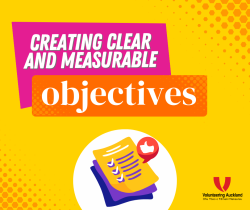How to Establish Clear, Measurable Objectives for a Volunteer Programme

Establishing clear, measurable objectives for a volunteer programme is essential for ensuring its effectiveness, sustainability, and impact. Without well-defined goals, it can be difficult to assess success and make informed decisions for improvement. This article outlines practical steps to set objectives and track key performance indicators (KPIs) that measure volunteer engagement and programme outcomes.
Step 1: Define the Programme’s Purpose and Goals
Before setting measurable objectives, it is crucial to have a clear understanding of the programme’s purpose. Ask the following questions:
- What is the primary mission of the volunteer programme?
- Who are the beneficiaries, and what impact should the programme have on them?
- What specific services or support will volunteers provide?
For example, if the programme’s mission is to improve literacy in underserved communities, a broad goal might be: To enhance reading skills among children aged 6-12 through weekly tutoring sessions.
Step 2: Develop SMART Objectives
Objectives should follow the SMART criteria:
- Specific – Clearly define what you want to achieve.
- Measurable – Establish criteria to track progress.
- Achievable – Set realistic goals within available resources.
- Relevant – Align objectives with the programme’s mission.
- Time-bound – Set deadlines for achievement.
Examples of SMART objectives for a literacy-focused volunteer programme could be:
- Recruit and train 50 volunteers within the first six months to conduct weekly reading sessions.
- Provide 100 children with at least 10 hours of one-on-one tutoring by the end of the first year.
- Improve reading proficiency levels by an average of 20% over a 12-month period.
Step 3: Identify Key Performance Indicators (KPIs)
KPIs help measure progress towards objectives. Effective KPIs for a volunteer programme may include:
-
Volunteer Engagement Metrics
- Number of active volunteers – Track the number of volunteers participating each month.
- Volunteer retention rate – Measure how many volunteers continue their involvement after a given period.
- Training completion rate – Assess how many volunteers complete initial and ongoing training sessions.
-
Event and Activity Participation
- Number of events conducted – Track the frequency and scale of volunteer activities.
- Volunteer attendance rate – Measure the percentage of volunteers who attend scheduled activities.
- Participant-to-volunteer ratio – Ensure a balance between volunteers and beneficiaries for effective engagement.
-
Impact on Beneficiaries
- Skill improvement assessments – Pre- and post-programme tests to measure improvements in literacy, job readiness, or other targeted skills.
- Beneficiary satisfaction surveys – Gather feedback from recipients on how the programme has helped them.
- Success stories and case studies – Document qualitative impact through real-life testimonials.
Step 4: Implement Data Collection Methods
Once KPIs are identified, set up systems to collect and analyse data. Methods may include:
- Digital Volunteer Management Systems – Use platforms like Better Impact, VolunteerHub, or Salesforce to track participation and training completion.
- Manual Attendance Logs – Keep records of volunteer hours and event participation.
- Surveys and Interviews – Collect qualitative and quantitative data from volunteers and beneficiaries.
- Impact Assessments – Use standardised tests or progress tracking tools for beneficiaries.
Step 5: Regularly Review and Adjust Objectives
Setting objectives is not a one-time task. Regularly review progress and adjust goals based on:
- Trends in participation and retention.
- Feedback from volunteers and beneficiaries.
- External factors, such as funding changes or evolving community needs.
For instance, if volunteer retention rates are lower than expected, it may indicate a need for better onboarding, recognition, or support structures.
Step 6: Communicate Objectives and Progress
Transparency is key to maintaining engagement and motivation. Ensure all stakeholders—including volunteers, staff, and beneficiaries—understand the programme’s objectives and progress. Strategies include:
- Regular progress reports – Share updates through newsletters, emails, or social media.
- Team meetings and feedback sessions – Encourage discussions on achievements and challenges.
- Recognition programs – Celebrate milestones, such as the completion of a set number of volunteer hours or significant beneficiary improvements.
Conclusion
Establishing clear, measurable objectives for a volunteer programme ensures its effectiveness and sustainability. By defining goals, setting SMART objectives, tracking KPIs, and using reliable data collection methods, organisations can enhance volunteer engagement and maximise impact. Regular evaluation and open communication will keep the programme aligned with its mission, fostering long-term success.

